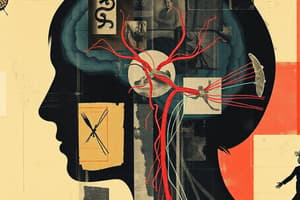Podcast
Questions and Answers
What informs us about the degree of muscle contraction and joint position?
What informs us about the degree of muscle contraction and joint position?
- Visual system
- Proprioceptors (correct)
- Brainstem
- Cerebellum
Which system is primarily responsible for maintaining postural balance?
Which system is primarily responsible for maintaining postural balance?
- Muscular system
- Vestibular system
- Nervous system
- Visual system (correct)
What is the primary function of the motor cortex in walking?
What is the primary function of the motor cortex in walking?
- Coordinating balance
- Maintaining body posture
- Regulating basic motor functions
- Initiating and controlling voluntary movements (correct)
Which region of the brain contributes to smooth and efficient walking?
Which region of the brain contributes to smooth and efficient walking?
What is the term for the precision of location in spatial awareness?
What is the term for the precision of location in spatial awareness?
What is the role of bones in walking?
What is the role of bones in walking?
What happens to the response at the center of the receptive field?
What happens to the response at the center of the receptive field?
What is the process that increases acuity?
What is the process that increases acuity?
What is the role of nerves in walking?
What is the role of nerves in walking?
What is the state of being aware of one's thoughts, feelings, and surroundings?
What is the state of being aware of one's thoughts, feelings, and surroundings?
What type of receptors respond rapidly at the onset of a stimulus but slow down or stop firing during the remainder of a stimulus?
What type of receptors respond rapidly at the onset of a stimulus but slow down or stop firing during the remainder of a stimulus?
What is the process by which neural substrates are activated by physical stimuli, resulting in the perception of touch, pressure, pain, etc.?
What is the process by which neural substrates are activated by physical stimuli, resulting in the perception of touch, pressure, pain, etc.?
What is the relationship between the visual system and the vestibular system in maintaining balance?
What is the relationship between the visual system and the vestibular system in maintaining balance?
What is the special sense based on the transduction of light stimuli received through the eyes?
What is the special sense based on the transduction of light stimuli received through the eyes?
What is the process by which the ear transforms sound vibrations in the external environment into nerve impulses?
What is the process by which the ear transforms sound vibrations in the external environment into nerve impulses?
Where do sound waves travel after striking the eardrum?
Where do sound waves travel after striking the eardrum?
What is the primary function of the association cortex?
What is the primary function of the association cortex?
What is the term for the process by which the brain interprets the meaning of sensory stimuli?
What is the term for the process by which the brain interprets the meaning of sensory stimuli?
What aspect of a stimulus is coded by the site of the stimulated receptor?
What aspect of a stimulus is coded by the site of the stimulated receptor?
Which cortical areas are involved in recognizing the relationships between body parts?
Which cortical areas are involved in recognizing the relationships between body parts?
What is the result of repeated stimulation of a neural pathway?
What is the result of repeated stimulation of a neural pathway?
What determines the strength of a receptor potential?
What determines the strength of a receptor potential?
What happens to stimuli that we repeatedly encounter and pay attention to?
What happens to stimuli that we repeatedly encounter and pay attention to?
What is the term for the process by which sensory information is coded into neural signals?
What is the term for the process by which sensory information is coded into neural signals?
Flashcards are hidden until you start studying
Study Notes
Somato-Sensation
- Somato-sensation is the physiological process by which neural substrates are activated by physical stimuli, resulting in the perception of touch, pressure, pain, etc.
Receptors and Acuity
- Acuity is negatively correlated with the amount of convergence in ascending pathways, size of the receptive field, and overlap with adjacent receptive fields.
- Response is highest at the center of the receptive field since receptor density is the highest there.
- Lateral inhibition increases acuity by inhibiting information from neurons at the edge of a stimulus.
Receptor Types
- Rapid adapting receptors respond rapidly at the onset of a stimulus but slow down or stop firing during the remainder of a stimulus, important for signaling rapid change.
- Slow adapting receptors maintain their response at or near the initial level of firing through the duration of the stimulus, important for signaling slow changes.
Vision
- Vision is the special sense of sight that is based on the transduction of light stimuli received through the eyes.
- The visual system is the primary receiver of sensory information to maintain postural balance, working together with the vestibular system.
Hearing
- Hearing is the process by which the ear transforms sound vibrations in the external environment into nerve impulses that are conveyed to the brain, where they are interpreted as sounds.
- The process involves the outer ear, eardrum, ossicles, and inner ear, where sound waves are converted into electrical impulses.
Proprioception
- Proprioceptors embedded in muscles and tendons inform us of the degree to which muscles are stretched, amount of tension in tendons, and position of joints.
Walking
- Walking is a complex process that involves various mechanisms and functions of the body coordinated by the brain.
- The muscular system, skeletal system, and nervous system are involved in walking, with the brain playing a crucial role in initiating and controlling movement.
Role of Brain in Walking
- The motor cortex initiates and controls voluntary movements, including walking, sending signals to muscles to contract and relax in a coordinated manner.
- The cerebellum plays a crucial role in balance coordination and motor learning, contributing to smooth and efficient walking.
- The brainstem regulates basic motor functions and reflexes involved in walking, such as maintaining body posture and adjusting gait in response to changes in terrain.
Consciousness and Behavior
- Consciousness refers to the state of being aware of and able to perceive one's thoughts, feelings, and surroundings.
- Behavior refers to the actions or reactions exhibited by an individual in response to internal or external stimuli.
States of Consciousness
- Consciousness refers to our subjective experience of the world around us and our inner mental states, including normal waking state, sleep, dreaming, and meditation.
Association Cortex and Perceptual Processing
- The association cortex is a part of the cerebral cortex that performs complex cognitive functions, including recognition of shape, form, textures of objects, awareness of body image, and relationships of body parts.
- Perceptual processing involves the evaluation and interpretation of sensory stimuli, which can become adapted and cease to be remarkable over time.
Primary Sensory Coding
- Sensory coding involves the coding of 4 aspects of a stimulus: stimulus type (modality), stimulus intensity, stimulus location, and duration.
- Stimulus type is coded by the type of receptor activated, intensity by the magnitude of the receptor potential, and location by the site of the stimulated receptor.
Studying That Suits You
Use AI to generate personalized quizzes and flashcards to suit your learning preferences.





